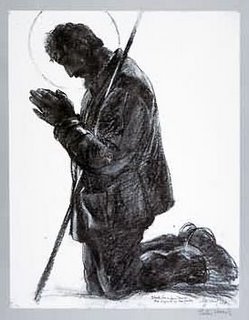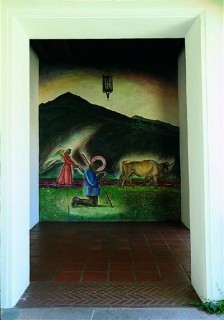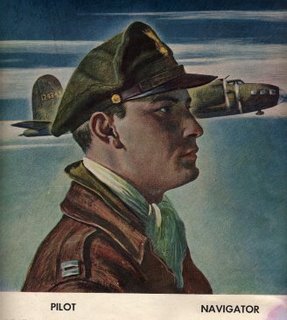

This brilliant color is a photograph of a window in a hotel in Albuquerque depicting the painting Karen speaks of in her essay.
Click here for a GIF image (which I can't save on Blogger) of this painting as well as the legend.

And now, on to the winning author, Karen Grigsby, STAR STUDENT.
can you $ay $hoes?
Peter Hurd and the Legend of San Ysidro
When Gunz up posted the portraits of Airmen painted by Peter Hurd, Life Magazine's war correspondent during World War II, I was particularly drawn back, time and again, to these wonderful paintings. I love how true to life they are and the attention paid to every detail of each man and his job is now a recorded part of our history that would be lost to us if not for these works. When the Teach requested an essay on either this artist or Michael Reagan, I immediately picked Peter Hurd because of this history. Life Magazine was one of the first publications that wanted to present the "mysteries and spectacle of war" and Peter Hurd was one of seven chosen combat artists sent to war theatres to create sketches and paintings of what they saw first hand.
As I researched further, I learned that not only did he serve our country in this way during World War II with his artistic talent, his whole life was dedicated to his art and he was also renowned for his murals and paintings depicting the history of Southwestern life here in America.
I was pleasantly surprised to learn that he was born in Roswell, New Mexico in 1904. He was raised in the life of ranching and farming and he found beauty in the New Mexico landscape. He loved the Military and attended West Point, but he also had a love of his art, painting. He left West Point after a couple of years in 1923 to go to Chadds Ford, Pennsylvania, where he met and became a student of N.C. Wyeth, a renowned illustrator that he deeply admired and respected. For ten years he lived and painted under the strict guidance of Wyeth, and in 1929, he married Wyeth's oldest daughter, Henriette, who is also an accomplished artist. After marrying, he longed for home in his beloved New Mexico, so he moved his new wife to Sentinal Ranch in San Patricio, New Mexico, where they lived and shared a studio and their love of painting.
In 1959, Hurd was appointed to the Presidents Commission of Fine Arts by President Dwight D Eisenhower and in 1966 he painted the official portrait of President Lyndon B Johnson, which was rejected by Johnson, and now hangs in the National Portrait Gallery.
As I looked on the internet at his works, that to this day are displayed in galleries and museums throughout the country, I was pulled into the beautiful murals and paintings of farming and ranch life, the wonderful landscapes of the sometimes desolate beauty of his surroundings. Paintings with names like Artesian Windmill, Hondo Valley, Sunday Afternoon in New Mexico and Rio Hondo. I was especially touched by one of his paintings called “The Legend of San Ysidro". The painting is a tranquil scene of a valley, nestled beneath mountains, depicting a day in the life of San Ysidro. It is one of the most beautiful and peaceful paintings I have ever seen. Peter Hurd generously donated this painting to the St. Jude Catholic Mission in San Patricio, New Mexico in 1967 and the following is the text from the document, handwritten by Peter Hurd that accompanied the gift of the painting. I think it describes this beautiful painting perfectly, and you can feel his art, his love of capturing the moment and his love of the panoramic views surrounding him through his own words
:
“The Legend of San Ysidro"
Many years ago in far away Spain, which is a country that looks very much like New Mexico, there lived a man named Ysidro. A good man, being both devout and hard working he was destined to become a saint. Although Ysidro's last name is lost in the dust of centuries, it is known that he was a faithful and trusted laborer for a rich farmer named Juan Vargas. But as sometimes happens among people, a spirit of envy and resentment toward Ysidro arose among the other workers on the farm. At first Don Juan paid no attention to this but as the gossip continued and other workers reported that Ysidro really didn't work nearly as hard or faithfully as some people believed, Don Juan decided to see for himself.
So early one morning while dew glistened on the grass and before the sun had peeped from behind the foothills of the Sierra Guadarrama, Don Juan walked toward a field, which Ysidro had been told to plow. After pushing through a willow thicket that flanked a beautiful mountain stream, very much like our own Rio Ruidoso, he came suddenly to the field and there before him was Ysidro, but instead of plowing the earth as he has been told to do he was kneeling, his head bowed and hands clasped. His Patron was on the very verge of telling him angrily that he should be working and not loafing while the field went unplowed. But the scolding was never delivered for suddenly a most awesome and beautiful sight drew the attention of Don Juan Vargas. For there behind the kneeling figure of Ysidro who remained lost in a devotional dream, there gliding slowly across the field was a yolk of milk-white oxen. Holding the plow which the oxen were pulling was a winged angel wearing a golden surcoat
.
And so Ysidro's name has come down through the years ever since the 12th century when he lived. Throughout the Spanish speaking countries he is known as San Ysidro, El Labrador, the patron saint of farmers and ranchers and workers everywhere
.
This painting is a gift to the new church of San Patricio and to my neighbors up and down the valley. I hope that they will share with me my delight in the subject. As they will see, I have not painted the dress and implements of the 12th century in Spain; rather I have attempted to stress the universal and timeless beauty of the Legend of San Ysidro, making him someone who might have lived in our own valley and in Recent Times.
Peter Hurd
San Patricio
September 1967
by aunt karen
2 comments:
Very good Karen now please tell me why you do not contribute to this blog as one of the principals so we can enjoy your writing talent. I saw some of the works by N>C> Wythe displayed in Snyder texas one time and it was breath taking how good he really was. Peter Herd studied under the master as far as I am concerned.I love you Vigie Bell says
Yes, Karen. She knows she's always invited.
Kayla just emailed me. She's going to work on a poem so maybe we'll have that in a day or two.
I love my girls.
The Teach
Post a Comment